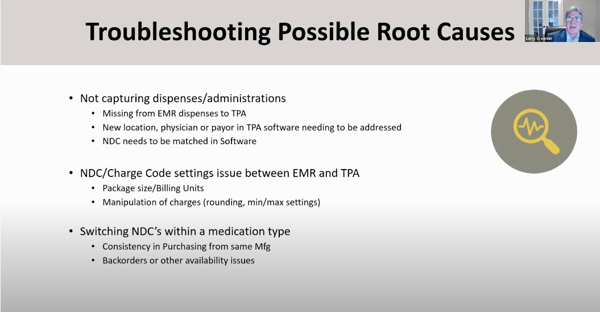
Modern Healthcare Technology Blog

Webinar Rewind: Don't Get WAC'd: Part 2
It’s no secret that a 340B Program is a multifaceted solution to a very serious problem: access to healthcare in underserved communities. That’s why it’s critical to understand wholesale acquisition costs and how they impact your 340B program.
This is part 2 of our latest Webinar Rewind, “Don't Get WAC'd: Minimizing WAC Exposure for DSH and PED hospitals.” Experts Larry Crowder, Cervey’s Senior Director of 340B Solutions, and Stephanie Dyer, 340B Program Analyst at Children's Healthcare of Atlanta, continue their discussion about wholesale acquisition risk in 340B hospitals subject to GPO prohibition, covering financial implications, strategies, and insider insights surrounding WAC exposure. If you missed part 1, you can get caught up here.
Topics:
Root Causes | NDC & Charge Code Issues | Switching NDCs Within a Medication Type
The Root Causes of Getting WAC’d
Larry Crowder:
 "Troubleshooting the root causes. Again, once you find out here are some items that either quantity, as Stephanie said, or money-wise, dollar-wise, there's a lot of WAC activity going on with this item, what do you do to troubleshoot those root causes? Starting out with just talking about capturing the dispenses. If you go to your EMR system and you go to your TPA system you want to make sure that all that data is coming across to your third-party administrator. If the data's not getting into the software itself then obviously that's going to cause you to have some WAC purchases. One of the first things you want to do is make sure that that data for that NDC is coming into the software appropriately."
"Troubleshooting the root causes. Again, once you find out here are some items that either quantity, as Stephanie said, or money-wise, dollar-wise, there's a lot of WAC activity going on with this item, what do you do to troubleshoot those root causes? Starting out with just talking about capturing the dispenses. If you go to your EMR system and you go to your TPA system you want to make sure that all that data is coming across to your third-party administrator. If the data's not getting into the software itself then obviously that's going to cause you to have some WAC purchases. One of the first things you want to do is make sure that that data for that NDC is coming into the software appropriately."

NDC & Charge Code Issues
Larry Crowder:
"The second thing is you want to make sure that nothing is being held out because of a location that has not been added to your software or a physician that hasn't been added to your list. If a physician who is writing that NDC is not on the eligible physician's list that obviously is going to hold out the item and you're not going to be able to get the benefit of the accumulations, and purchases, of GPO and 340B for that item. It's going to all go to WAC."
"And then finally you want to make sure that the NDC is matched in the software. I know every piece of software, every vendor, has this little module where you can match numbers that come across. If it's a hospital charge code number, or if it's a fake NDC, or if it's an inner NDC to the outer NDC, something like that's coming across that the system has not recognized or has not attached it to the appropriate NDC in your item catalog then they have a little module where you can link those together. If you don't have those linked together, or if you're ignoring an item (if you have some usage coming in and for some reason it was ignored) you want to make sure that you're reviewing those things, and looking for those, and linking those together. Because if you're truly using those items in the inpatient and outpatient areas then you're going to be purchasing those at WAC until they are linked, and then accumulate appropriately to the right inpatient/outpatient bucket."
"The NDC/charge code settings issue, this is something that has to do really with billing units. If your EMR system is sending out everything in a quantity of one, so it's one vial, one bottle, and then your software believes that everything's coming in MLs it's going to take you a really long time to add up to get a package. If your MLs are 120 it's going to wait for 120 vials, or 120 bottles, to accumulate before it allows you to order one package. You want to make sure that those things are communicating well. I know some vendors use multipliers here, some vendors actually match the way it's coming across to our package size or billing unit. But you want to make sure that those are correct. And then the manipulation of charges would include if you have a multiplier on it or if you have a round up functionality to catch your waste, that those are accurately inputted into the software. You don't want to over or under accumulate based on an erroneous multiplier."
Switching NDCs Within a Medication Type
Larry Crowder:
"And, finally, switching NDCs within a medication type. This one's a little bit more sensitive. Sometimes you're dealing with availability issues, you have backorder issues, and you just can't get one NDC. But generally you want to keep the consistency of buying the same NDC so that you can accumulate fully. As you can imagine if you're buying two or three different NDCs each one of those would have to accumulate to a full package before you could buy it on GPO or 340B. So if you're buying two or three different items it's going to take longer for any one of those to accumulate to a full package, you want to make sure that you're being consistent. And that really comes in with communicating with the buyers."
"And I know, Stephanie, you have a relationship with your buyers. Can you speak to what you do with your buyers and what you look for every day, so that you and your buyers communicate well on limiting those WAC purchases?"
Stephanie Dyer:
"With that new report item that gets emailed to us daily they also see that as well, so they can email me ahead of time if they know the answer already. But I'll just look at that and I'll put a comment to them saying, "Is this temporary? Is this a permanent change? Is this a backorder issue?" So that way they can let me know if we need to change up our NDC so we can accrue it correctly."
"I work our buyers on the WAC savings or losses weekly report constantly. They're also asking me, "Hey, do you see any accruals coming over in the next day or so?" Then I can give them a heads up, "Yeah, hey I just pushed this charge through today. It'll be there tomorrow. Can you wait until tomorrow afternoon to place your order coming in later that week?" So it really helps to just have that really good rapport with your buyers, and that they can come to you and you can come to them, and ask them anything."
Larry Crowder:
"That's an important point too that Stephanie just made. Stephanie has a really good relationship with her buyers, so she's actually managing two locations so she has two different buyers, and more than that really but two different main buyers, one at each of those locations and they have a really good relationship. So she's not coming in knocking them over the head about what's going on here. They're really just communicating and they both are on the same page, as to they understand why WAC is such a negative impact to the hospital and why it's important to limit those purchases."
Follow us to stay tuned for part 3 of the Webinar Rewind series for “Don't Get WAC'd: Minimizing WAC Exposure for DSH and PED hospitals” here:
Looking for the rest of the webinar series? Check out parts 1 and 3-4 below:


